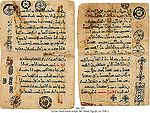- Maron
-
For the companion of Dionysus, see Maron (mythology).
Saint Maroun 
Saint MarounBorn Unknown Died 410 AD
Kefar-Nabo, Ol-Yambos, SyriaHonored in Catholic Church, Eastern Orthodox Church Feast February 9 Part of a series of articles on the
Maronites
History
History of Phoenicians
Byzantine Empire · Crusades
Marada · Mardaites
History of Lebanon
1958 Lebanon crisis · Lebanese Civil WarReligious affiliation
Maronite Catholic Patriarchate of Antioch and All the East
Lebanese Maronite Order
Mar Bechara Boutros RaïPolitics
Lebanese politics
Lebanese nationalism
Phoenicianism
Kataeb Party · March 14 AllianceLanguages
Cypriot Maronite Arabic · Lebanese Arabic · Aramaic
ArabicCommunities
Cyprus · Israel · Lebanon · Jordan · Syria
DiasporaCategories:- 410 deaths
- 4th-century births
- 4th-century Romans
- 5th-century Byzantine people
- Syrian hermits
- Christian mystics
- Maronites
- Lebanese Maronites
- Syrian Roman Catholic saints
- Lebanese Roman Catholic saints
- 5th-century Christian saints
Wikimedia Foundation. 2010.
Look at other dictionaries:
Mâron — Mâron … Deutsch Wikipedia
Mâron — País … Wikipedia Español
Marón — puede referirse a: Religión San Marón (3?? 410), abad de San Ciro en Siria. San Marón (?? 99), mártir. Mitología Marón, compañero de Osiris. en Francia Maron, población y comuna de Meurthe y Mosela. Mâron, población y comuna de Indre … Wikipedia Español
Mâron — Mâron … Wikipedia
maron — MARÓN adj. v. maro. Trimis de claudia, 24.08.2008. Sursa: DEX 98 marón adj. m., pl. maróni; f. sg. marónă, pl. maróne Trimis de s … Dicționar Român
Maron — {{Maron}} Priester des Apollon*, von Odysseus* bei der Eroberung der Stadt Ismaros verschont. Unter den Gaben, die Maron daraufhin überbringen ließ, befanden sich auch zwölf Krüge Wein, »ein Göttertrank«, der so stark war, daß er zwanzigfache… … Who's who in der antiken Mythologie
Maron — Maron, Sohn des Euanthes, Enkel des Dionysos u. der Ariadne, war Priester des Apollo zu Maronea am Ismaros zur Zeit des Trojanischen Krieges u. gab dem Odysseus trefflichen Wein; nach Einigen gehörte er zu den Begleitern des Bakchos … Pierer's Universal-Lexikon
Maron — (spr. óng, Marron, Marun, Maroon), Buschneger, die Nachkommen von entlaufenen Negersklaven im Innern von Guayana und Westindien … Kleines Konversations-Lexikon
Maron — MARON, ónis, Gr. Μάρων, ωνος, des Evantheus Sohn, und Priester des Apollo, welcher dem Ulysses den Wein gab, womit er hernach den Polyphemus voll fäuste. Hom. Od. 1. v. 197. Es heißt daher Maro dann und wann bey den Poeten selbst so viel, als der … Gründliches mythologisches Lexikon
Maron [1] — MARON, nis, einer von denen Helden, die sich nach dem Leonidas bey Thermopylä am tapfersten gehalten, und dem man nachher deswegen einen Tempel zu Sparta errichtet hatte. Pausan. Lacon. c. 12. p. 183 … Gründliches mythologisches Lexikon
màrōn — (màrūn) m 〈G maróna〉 1. {{001f}}bot. a. {{001f}}reg. pitomi kesten, {{c=1}}usp. {{ref}}kesten ∆{{/ref}} b. {{001f}}pitomi kesten izrazito velikog ploda [lovranski ∼i] 2. {{001f}}nijansa smeđe boje ✧ {{001f}}tal … Veliki rječnik hrvatskoga jezika

